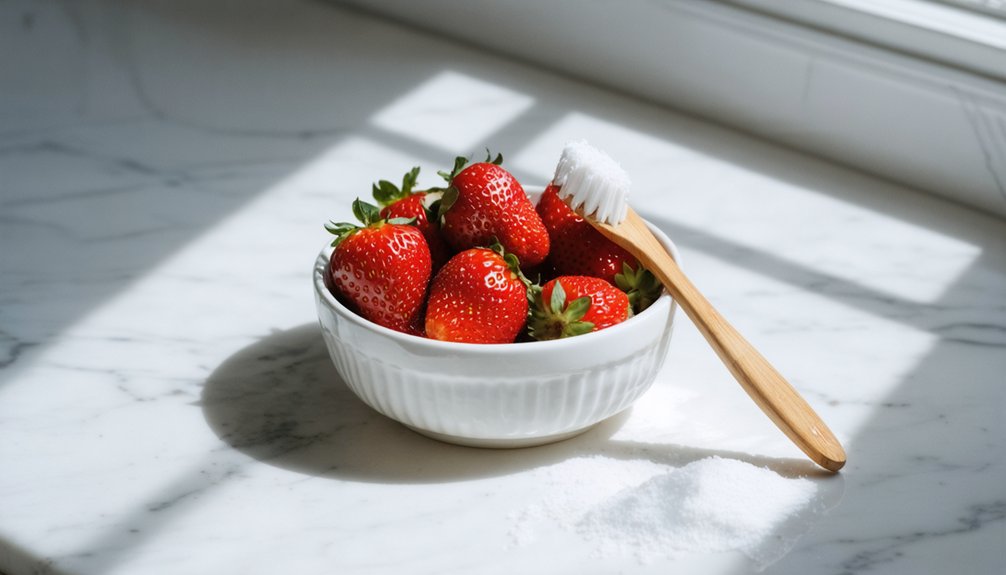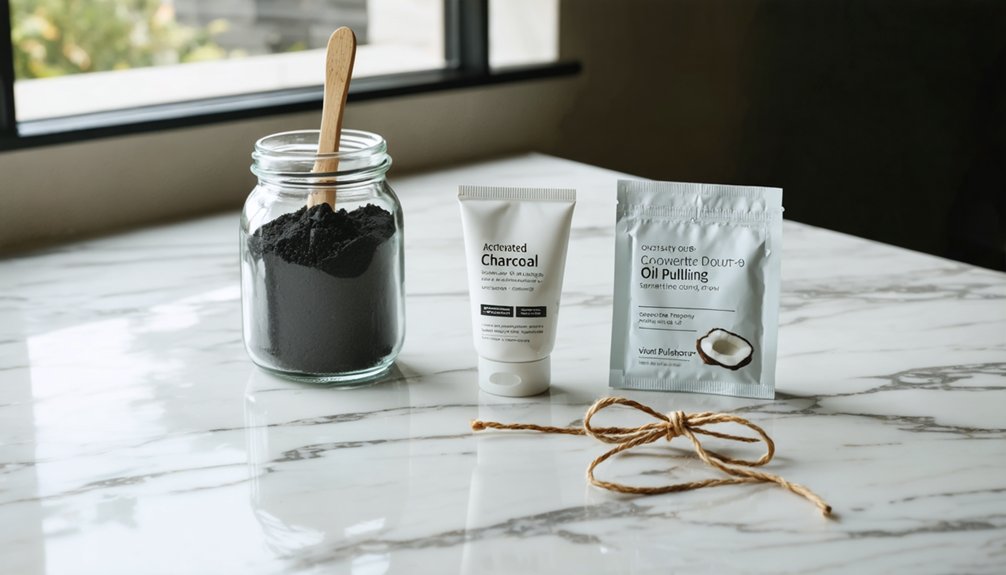You can effectively whiten sensitive teeth using three gentle, natural approaches. Start with oil pulling using coconut or sesame oil for 15-20 minutes daily to reduce surface stains through antimicrobial action. Incorporate calcium-rich foods like yogurt and cheese to strengthen your enamel while naturally brightening teeth. Choose specialized peroxide-free whitening products containing protective ingredients like potassium nitrate. These evidence-based methods offer progressive results while prioritizing your comfort and oral health.
Key Takeaways
- Oil pulling with coconut or sesame oil for 15-20 minutes daily provides gentle whitening while supporting oral health.
- Consume calcium-rich foods like yogurt and cheese to strengthen enamel and naturally brighten teeth.
- Eat crunchy fruits and vegetables like apples and celery, which naturally clean teeth and remove surface stains.
- Use peroxide-free natural whitening products specifically designed for sensitive teeth, such as Oral Essentials Lumineux Kit.
- Maintain consistent oral hygiene with fluoride toothpaste and gentle brushing techniques to prevent sensitivity while whitening.
Oil Pulling: A Gentle Daily Whitening Ritual
Oil pulling, an ancient Ayurvedic practice spanning over 2,500 years, has gained renewed attention as a gentle approach to dental care. While research doesn’t support dramatic whitening claims, this technique may help reduce surface stains through its antimicrobial properties and plaque-reduction effects.
Oil pulling harnesses ancient Ayurvedic wisdom to gently support dental health, offering subtle stain-reducing benefits through natural antimicrobial action.
To experience oil pulling benefits, swish one tablespoon of coconut, sesame, or olive oil in your mouth for 15-20 minutes daily. You’ll want to breathe through your nose and maintain gentle swishing motions. According to scientific reviews, oil pulling may be as effective as chlorhexidine mouthwash for reducing plaque. Since coconut oil is most commonly used, many prefer it for its antimicrobial benefits and pleasant taste.
Afterward, dispose of the oil in the trash—never swallow it or spit it into plumbing.
While oil pulling won’t replace professional whitening treatments, it can complement your oral care routine. Studies show it reduces bacterial colonies in saliva, which may contribute to fresher breath and improved oral hygiene when combined with regular brushing and flossing.
Smart Dietary Choices for Natural Teeth Whitening
While achieving a brighter smile through whitening treatments is important, maintaining those results requires strategic dietary choices that protect sensitive teeth.
Plain white yogurt and other milk products help strengthen tooth enamel after whitening procedures. You’ll want to prioritize dairy benefits by incorporating calcium-rich products like yogurt and cheese, which fortify enamel and stimulate natural cleansing saliva production. Select protein sources such as white fish, skinless chicken, and tofu that won’t compromise your whitening results.
Include crunchy produce like apples and celery to naturally cleanse teeth through mechanical action, while choosing white grains and starches that pose minimal staining risks. Using a straw when drinking any colored beverages can help protect your newly whitened teeth from staining.
Remember to avoid acidic foods, dark pigments, and extreme temperatures that can trigger sensitivity. This all-encompassing approach to diet not only preserves your whitening results but also supports ongoing oral health and comfort.
Specialized Sensitive Teeth Whitening Products
When seeking professional-grade whitening results for sensitive teeth, specialized products offer carefully formulated solutions that prioritize comfort without compromising effectiveness.
You’ll find low peroxide options like Crest 3D White Whitestrips Gentle Routine, which contains minimal concentrations to reduce irritation while still achieving noticeable results.
For those requiring natural alternatives, products like Oral Essentials Lumineux Kit utilize peroxide-free formulations enhanced with coconut oil and sage oil.
LED technology, featured in the SNOW Teeth Whitening Kit, pairs with gentle ingredients to deliver professional results at home. The advanced LED light enhances the whitening process while remaining gentle on sensitive teeth.
These specialized solutions often incorporate protective ingredients like potassium nitrate and fluoride to block nerve sensitivity and strengthen enamel during the whitening process.
You’ll experience gradual whitening effects rather than immediate results, ensuring peak comfort throughout your treatment. Regular professional dental exams help monitor sensitivity levels and ensure the chosen whitening method remains suitable for your teeth.
Frequently Asked Questions
How Long Does Natural Teeth Whitening Take to Show Visible Results?
You’ll notice initial results from natural remedies within 3-7 days, with significant whitening visible after 2-3 weeks of consistent use, though your individual whitening timeline varies by stain type.
Can Children Safely Use Natural Teeth Whitening Methods?
You shouldn’t use whitening methods on children under 15 due to safety concerns. Even natural alternatives require professional guidance, as developing teeth are sensitive and have age restrictions for all whitening treatments.
Will Coffee Stains Respond Better to Oil Pulling or Baking Soda?
Baking soda’s effectiveness will deliver faster results on coffee stains through gentle abrasion, while oil pulling benefits are gradual. You’ll see more immediate stain removal using baking soda with proper, careful application.
Does Fluoride Treatment Affect the Effectiveness of Natural Whitening Methods?
Fluoride won’t diminish your natural whitening results, and it’ll actually support them by strengthening your enamel. When considering fluoride alternatives for sensitivity concerns, you’ll still maintain whitening effectiveness while protecting teeth.
Should Natural Whitening Methods Be Avoided During Dental Work or Braces?
You’ll need to avoid natural whitening during dental work and braces since acids and abrasives can damage enamel, increase natural sensitivity, and compromise treatments. Always seek dental consultation before attempting whitening.
References
- https://www.healthline.com/nutrition/whiten-teeth-naturally
- https://libertydentalplc.com/why-you-should-avoid-natural-teeth-whitening-methods/
- https://www.sensodyne.com/en-us/oral-health-tips/whitening-sensitive-teeth/what-to-know/
- https://www.pleasantfamilydentistry.com/blog/6-natural-ways-to-whiten-your-teeth
- https://www.goodrx.com/conditions/dental-care/sensitive-teeth-after-whitening
- https://www.txdentisttree.com/blog/teeth-whitening-for-sensitive-teeth-cip1800/
- https://pmc.ncbi.nlm.nih.gov/articles/PMC4058574/
- https://www.ada.org/resources/ada-library/oral-health-topics/whitening
- https://journals.sagepub.com/doi/pdf/10.1177/2229411220160104
- https://pmc.ncbi.nlm.nih.gov/articles/PMC9602184/



